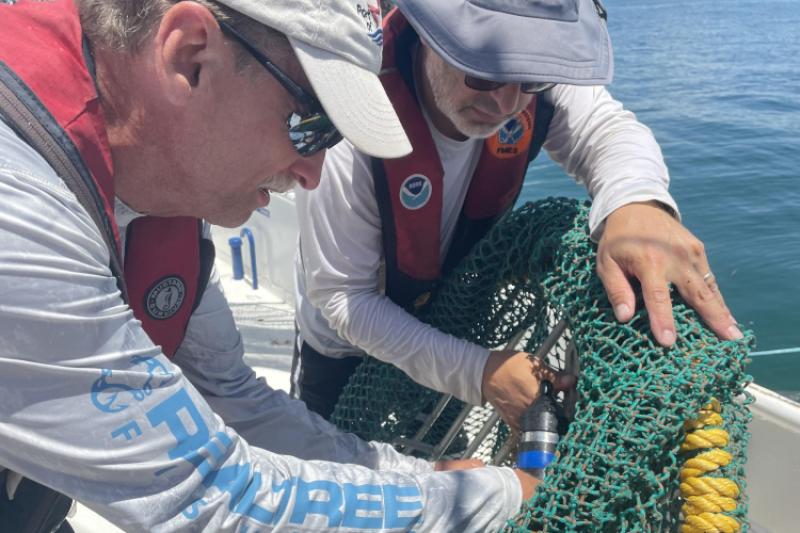“Turtle down,” someone calls over the radio. In about 2 minutes, the team in the small boats start scanning the surface watching for a small green buoy to appear. The buoy is attached to a juvenile loggerhead sea turtle, which is really what everyone is looking for. Once the buoy surfaces, the “catch boat” team motors towards it, scooping the turtle from the water. Soon the turtle will be back in its tub on the research vessel—its home for the day.
This process has been happening for more than 30 years. The turtles, and those from previous years, are part of an important history that ultimately has led to conserving several sea turtle species around the world.
Reducing Bycatch
The unintended catch of non-targeted species, or bycatch, often includes protected species such as sea turtles, or juvenile fish of commercially and recreationally important species. In the 1970s, resource managers saw an increasing number of non-targeted species being caught in commercial fishing nets. Resource managers knew that if they could reduce the bycatch of sea turtles, it would be a concrete step in conserving these species. The “how” wasn’t as easy to figure out. The commercial fishing industry is important to the nation’s economy—and people’s livelihoods and way of life were at stake.
Our Southeast Fisheries Science Center staff in Pascagoula, Mississippi—in the heart of the Gulf of Mexico shrimping country—began talking with fishermen in their community and in their families about ways to fix this problem.
Since then, the gear team has used their shrimping background, education, problem-solving skills, and creativity to understand how modifying fishing gear can reduce bycatch while keeping U.S. fishermen in business. One gear innovation they helped test is the turtle excluder device, or TED, which helps sea turtles navigate out of trawl nets while keeping shrimp inside the net.
International Expertise
This team doesn’t just work with U.S. fishermen, though. Because they are the only ones who are doing in situ research by diving on trawl nets, they are sought out by many other countries. This summer, the gear team hosted two researchers from India who went out on the water with them to test out their designs.
“The international work that we do has proven very effective,” said Jeff Gearhart, Gear and Vessel Support Branch Chief. “We have worked closely with many countries to not only protect turtles and other protected species, but to also protect the U.S. seafood market.” It is illegal for nations to export wild-caught shrimp to the United States without sea turtle conservation measures equivalent to ours, which includes TED requirements.
Real-Time Innovation
The team tests TEDs and evaluates other bycatch reduction devices in real time. They use devices installed in commonly used commercial fishing gear, and towed by a “fishing vessel” like the R/V Caretta. This allows for the team to assess what’s happening under normal fishing conditions. For example, they’ve learned that having TEDs installed at angles less than 55 degrees is critical to allow small turtles to escape from the trawl while simultaneously maintaining shrimp catch.
What may seem like insignificant details are actually very important. “While working with a team in Australia years ago, we noticed that some TEDs performed differently than others,” said Dan Foster, Gear Research Branch Chief. “We realized this was dependent on which direction the knots in the netting were oriented—the water flow across the webbing actually pushed up or down on the escape opening flap depending on the knot orientation.”
Being able to evaluate different gear configurations using captive turtles also makes the research and development process more efficient. On each 1-hour dive, TEDs can be tested by as many as 12 turtles, whereas in the wild the team might only encounter three to four turtles during a full day's work. The turtles are released a few weeks after testing.







